Abstract
Certain spontaneous mutations of Drosophila melanogaster are suppressed by su(Hw), the suppressor of Hairy-wing (3R-54.8). We find that mutations suppressible by su(Hw) result from insertions of a mobile element at the affected loci. The element, named gypsy, is approximately 7.3 kilobases long and includes 0.5-kilobase direct terminal repeats. It was first identified in DNA cloned from the bithorax chromosomal region of several Drosophila stocks carrying suppressible mutations of the bithorax complex. Cloned gypsy DNA was used as a probe to test for the association of gypsy with suppressible mutations at various other loci by hybridization in situ. Gypsy was found to be associated with 19 suppressible alleles at 10 different loci: yellow, Hairy-wing, scute, diminutive, cut, lozenge, forked, Beadex, hairy, and the bithorax complex. It was found with wild-type or nonsuppressible mutations at any of these loci. Gypsy DNA was also used as a probe to clone the element and adjacent unique DNA from the loci of some suppressible mutations. This confirmed the presence of the full-length element and also provided cloned DNA from the previously uncloned loci scute and cut. The suppressor of Hairy-wing is generally recessive and behaves as a null mutation. Thus, the disruption of normal gene function caused by the inserted gypsy element appears to require some product of the wild-type suppressor gene, su(Hw)+.
Full text
PDF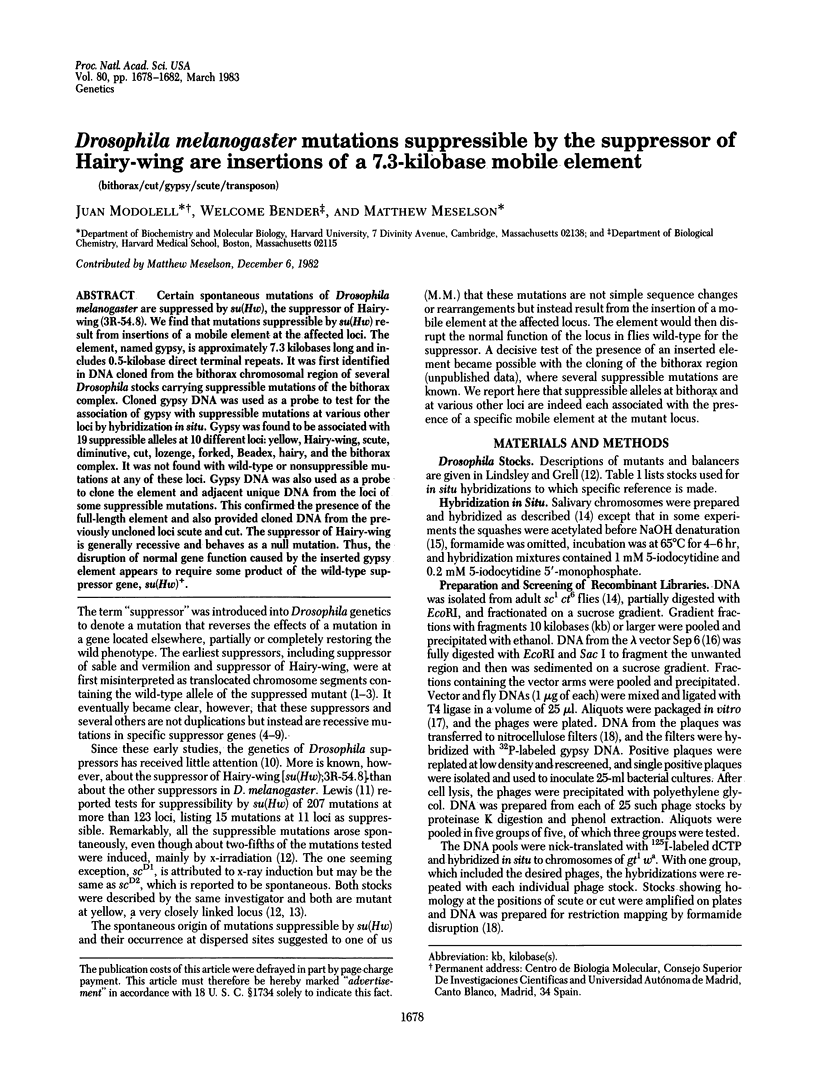
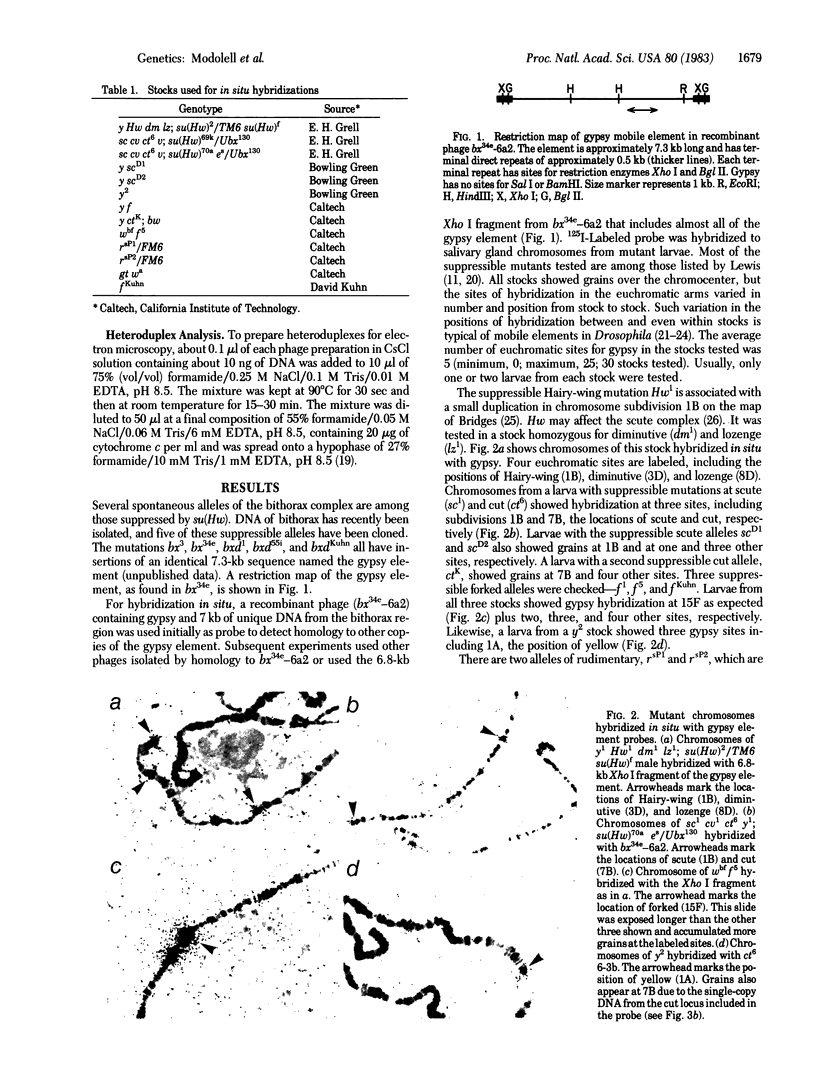
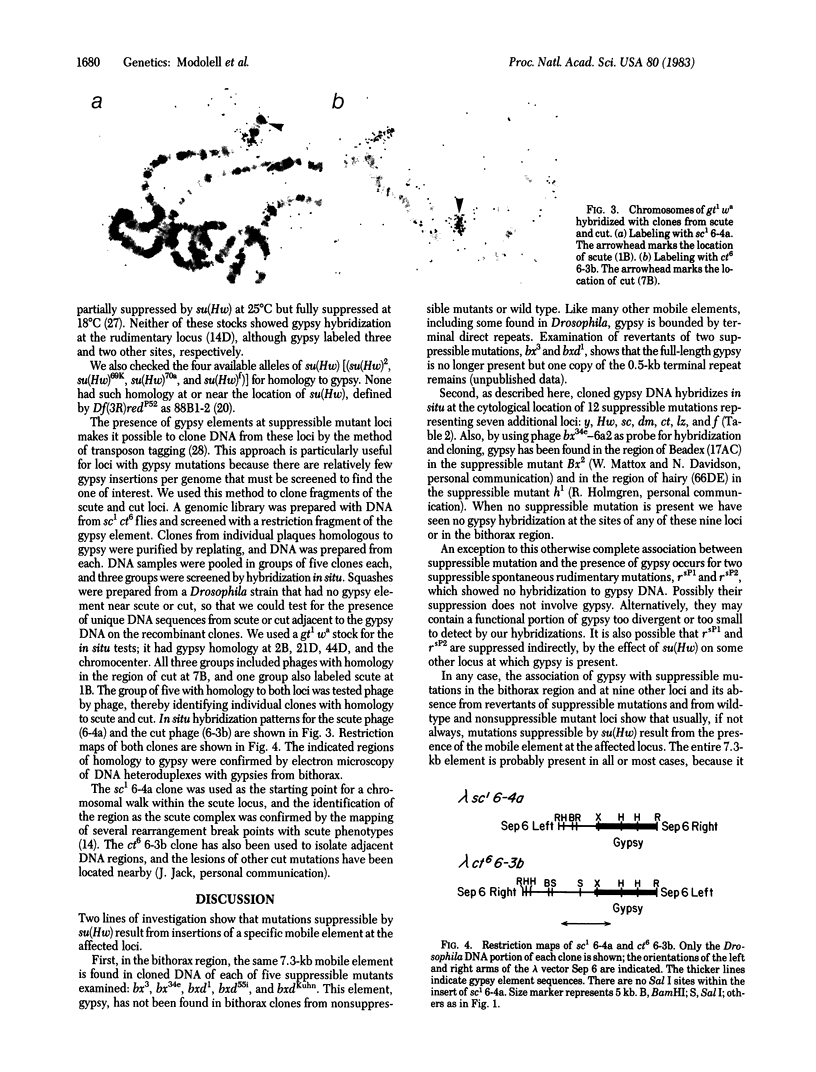
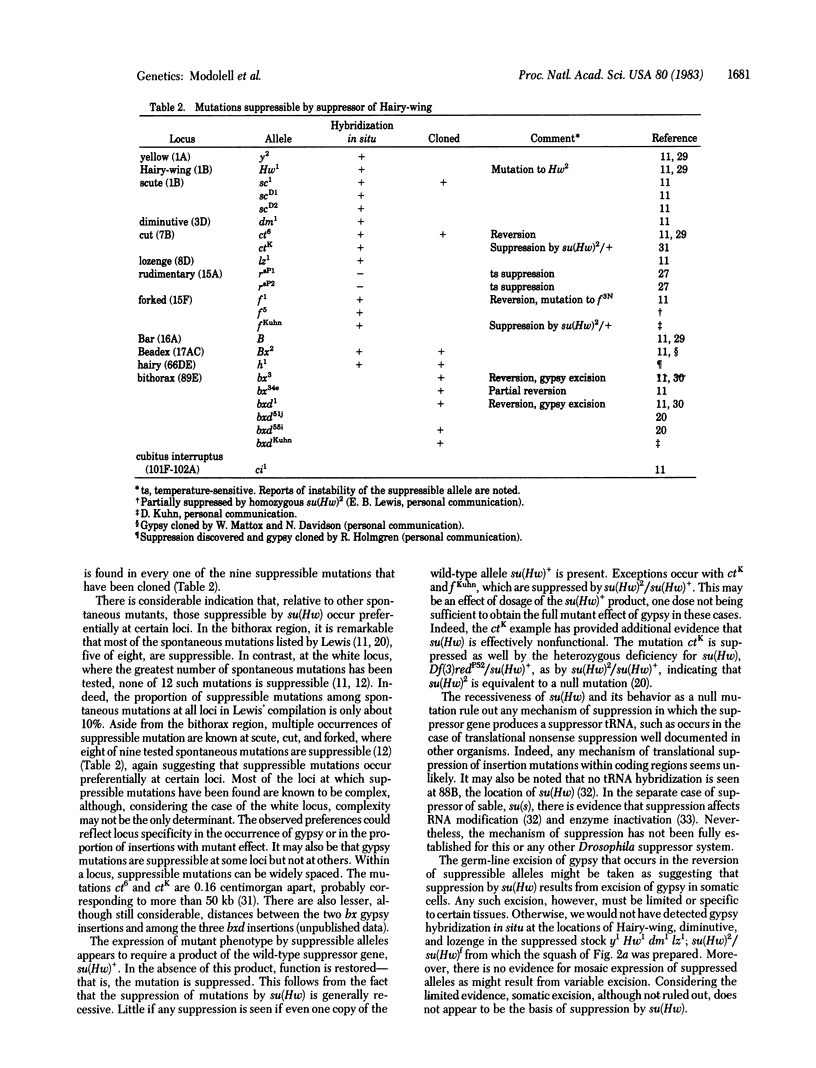
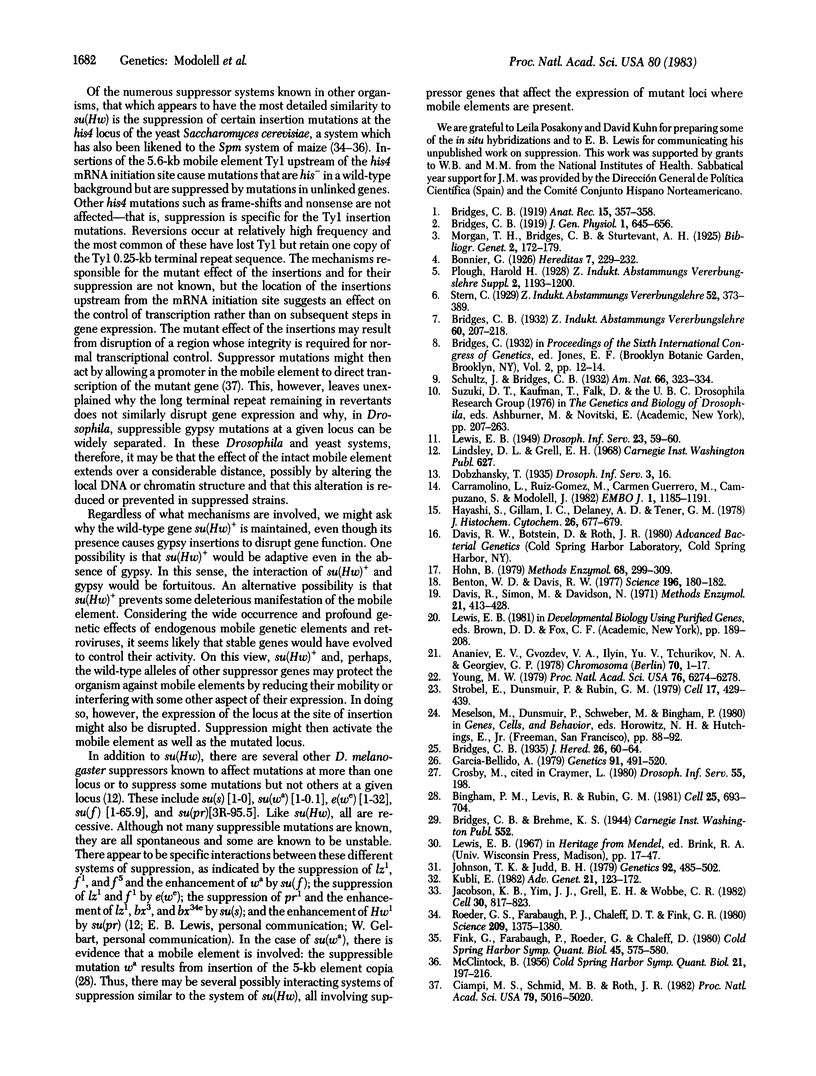
Images in this article
Selected References
These references are in PubMed. This may not be the complete list of references from this article.
- Ananiev E. V., Gvozdev V. A., Ilyin Yu V., Tchurikov N. A., Georgiev G. P. Reiterated genes with varying location in intercalary heterochromatin regions of Drosophila melanogaster polytene chromosomes. Chromosoma. 1978 Dec 21;70(1):1–17. doi: 10.1007/BF00292211. [DOI] [PubMed] [Google Scholar]
- Benton W. D., Davis R. W. Screening lambdagt recombinant clones by hybridization to single plaques in situ. Science. 1977 Apr 8;196(4286):180–182. doi: 10.1126/science.322279. [DOI] [PubMed] [Google Scholar]
- Bingham P. M., Levis R., Rubin G. M. Cloning of DNA sequences from the white locus of D. melanogaster by a novel and general method. Cell. 1981 Sep;25(3):693–704. doi: 10.1016/0092-8674(81)90176-8. [DOI] [PubMed] [Google Scholar]
- Carramolino L., Ruiz-Gomez M., Guerrero M. del C., Campuzano S., Modolell J. DNA map of mutations at the scute locus of Drosophila melanogaster. EMBO J. 1982;1(10):1185–1191. doi: 10.1002/j.1460-2075.1982.tb00011.x. [DOI] [PMC free article] [PubMed] [Google Scholar]
- Ciampi M. S., Schmid M. B., Roth J. R. Transposon Tn10 provides a promoter for transcription of adjacent sequences. Proc Natl Acad Sci U S A. 1982 Aug;79(16):5016–5020. doi: 10.1073/pnas.79.16.5016. [DOI] [PMC free article] [PubMed] [Google Scholar]
- Fink G., Farabaugh P., Roeder G., Chaleff D. Transposable elements (Ty) in yeast. Cold Spring Harb Symp Quant Biol. 1981;45(Pt 2):575–580. doi: 10.1101/sqb.1981.045.01.074. [DOI] [PubMed] [Google Scholar]
- García-Bellido A. Genetic Analysis of the Achaete-Scute System of DROSOPHILA MELANOGASTER. Genetics. 1979 Mar;91(3):491–520. doi: 10.1093/genetics/91.3.491. [DOI] [PMC free article] [PubMed] [Google Scholar]
- Hayashi S., Gillam I. C., Delaney A. D., Tener G. M. Acetylation of chromosome squashes of Drosophila melanogaster decreases the background in autoradiographs from hybridization with [125I]-labeled RNA. J Histochem Cytochem. 1978 Aug;26(8):677–679. doi: 10.1177/26.8.99471. [DOI] [PubMed] [Google Scholar]
- Hohn B. In vitro packaging of lambda and cosmid DNA. Methods Enzymol. 1979;68:299–309. doi: 10.1016/0076-6879(79)68021-7. [DOI] [PubMed] [Google Scholar]
- Jacobson K. B., Yim J. J., Grell E. H., Wobbe C. R. Mechanism of suppression in Drosophila: evidence for a macromolecule produced by the su(s)+ locus that inhibits sepiapterin synthase. Cell. 1982 Oct;30(3):817–823. doi: 10.1016/0092-8674(82)90286-0. [DOI] [PubMed] [Google Scholar]
- Johnson T. K., Judd B. H. Analysis of the Cut Locus of DROSOPHILA MELANOGASTER. Genetics. 1979 Jun;92(2):485–502. doi: 10.1093/genetics/92.2.485. [DOI] [PMC free article] [PubMed] [Google Scholar]
- Kubli E. The genetics of transfer RNA in Drosophila. Adv Genet. 1982;21:123–172. doi: 10.1016/s0065-2660(08)60298-9. [DOI] [PubMed] [Google Scholar]
- MCCLINTOCK B. Controlling elements and the gene. Cold Spring Harb Symp Quant Biol. 1956;21:197–216. doi: 10.1101/sqb.1956.021.01.017. [DOI] [PubMed] [Google Scholar]
- Roeder G. S., Farabaugh P. J., Chaleff D. T., Fink G. R. The origins of gene instability in yeast. Science. 1980 Sep 19;209(4463):1375–1380. doi: 10.1126/science.6251544. [DOI] [PubMed] [Google Scholar]
- Strobel E., Dunsmuir P., Rubin G. M. Polymorphisms in the chromosomal locations of elements of the 412, copia and 297 dispersed repeated gene families in Drosophila. Cell. 1979 Jun;17(2):429–439. doi: 10.1016/0092-8674(79)90169-7. [DOI] [PubMed] [Google Scholar]
- Young M. W. Middle repetitive DNA: a fluid component of the Drosophila genome. Proc Natl Acad Sci U S A. 1979 Dec;76(12):6274–6278. doi: 10.1073/pnas.76.12.6274. [DOI] [PMC free article] [PubMed] [Google Scholar]




